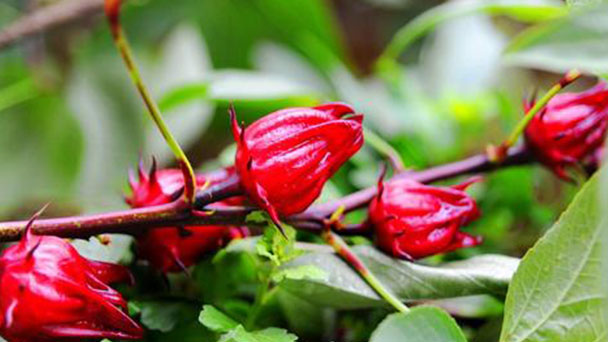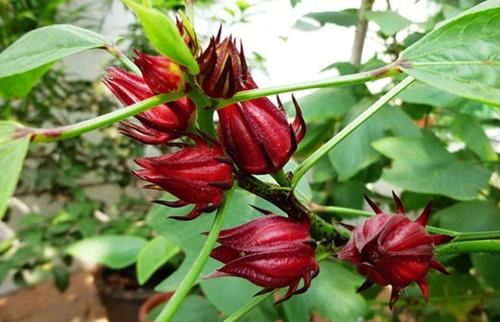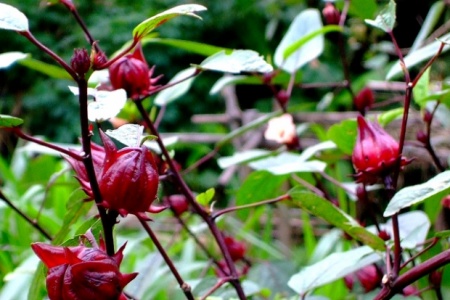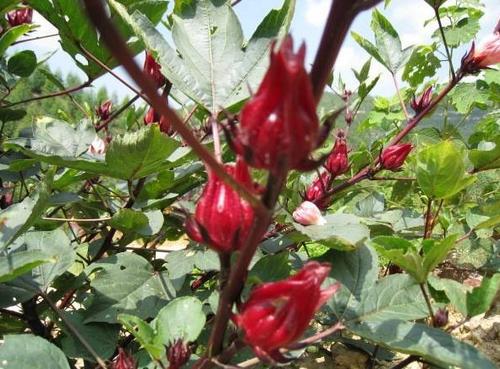Roselle (Hibiscus Sabdariffa) Profile: Plant Facts, Care & Growing Guide
Written by admin
Nov 13 2021

Roselle plant, scientific name Hibiscus sabdariffa, is widely distributed in tropical and subtropical areas, originally produced in West Africa, India. Roselle plants are 1.5 -- 2 m tall, with lavender stems, erect, and a much-branched trunk. Leaves are alternate. Roselle Flowers open in summer and autumn with long flowering, calyx cup-shaped, purple, yellow corolla. When the flowering season, they bloom red, green and yellow flowers, very beautiful, having the "plant ruby" reputation. Roselle has the effect of clearing away heat and relieving heat, beautifying, eliminating spots and relieving alcohol. Note: Roselle contains a lot of organic acids, so people with excessive stomach acid try not to eat it.
Roselle Picture

Morphological Characteristics of Roselle
Roselle plant is an annual erect herb, up to 2m tall, with a lilac, glabrous stem.
Leaves of Roselle are heteromorphous, lower leaves ovate, undivided, upper leaves palmately 3-lobed, lobes lanceolate, 2 -- 8cm long and 5 -- 15mm wide, serrate, apex obtuse or acuminate, base rounded to broadly cuneate, glabrous on both surfaces, main veins 3-5, middle rib glandular on abaxial surface; Petiole is 2 -- 8cm long, sparsely pilose; Stipules of Roselle are linear, ca. 1cm long, sparsely pilose.
Flowers of Roselle are simple, born in leaf axils, subsessile; Roselle has 8-12 bracteoles, red, fleshy, lanceolate, 5 -- 10mm long and 2 -- 3 mm wide, sparsely hirsute, with spiny appendages near apex, base connate with calyx; Calyx is cup-shaped, lavender, ca. 1cm in diam., sparsely spinaceous and hairy, connate at base 1/3, lobes 5, triangular-acuminate, 1 -- 2cm long; Flowers of Roselle are yellow, deep red on the inner base, 6 -- 7cm in diameter.
Capsule of Roselle is ovoid, ca. 1.5cm in diam., densely hirsute, mericarp 5; Seeds are reniform, glabrous. Flowering period is between summer and autumn.
Roots of Roselle protocone, taproot slightly thin, deeper into soil, glabrous. Leaves are atypical, proximally ovate, undivided, distally palmately 3-5-lobed, serrate, apex obtuse or acuminate, base rounded to broadly cuneate, glabrous, main veins 3-5. Stipules are strip, sparsely pilose. Peanut is yellow in the axils of leaves, with deep red at the base of the inner surface. Each Roselle generally has 50-100 flowers, or up to 300. The calyx is cup-shaped, composed of 5 inner sepal and 8 -- 12 bracteoles that form the epicalyx. Capsule is ovoid, there are 20-30 seeds, seeds kidney - shaped, dark gray - brown.
The Roselle flowers open in summer and autumn, the flowering period is long, the corolla is yellow, the sepals and epicalyx are rose-red, and the stem and petiole are often pale rose. In the flowering season, the flowers alternate with red, green and yellow, and are very lovely.
Natural habits of Roselle
Roselle plant is a tropical and subtropical short-day crop, light-loving, temperaturesophilic, and avoids early frost, the best growth at 25℃~30℃ conditions.
Generally, Roselle is sown in spring and harvested in autumn. The whole growth period is 160-200 days, and the effective accumulated temperature is about 500-550℃. There are certain requirements for temperature, humidity, illumination and soil conditions.
How to Grow and Care for Roselle
When to Grow Roselle
Roselle seed germinates at soil temperatures between 75°- 85°F, and does well directly sown in the garden. In the low desert of Arizona, plant roselle from seed or transplants once temperatures warm up in March through the end of May.
In cooler climates, start roselle from seed indoors 6-8 weeks before the last frost. When seedlings are 3-4 inches high, transplant them into a spot in the garden that gets full sun.
Where to Grow Roselle
Roselle plant prefers well-draining fertile soil. Overly rich soil or extra fertilization leads to a very large plant with fewer calyces. A sunny spot is best for growing roselle successfully. In the low-desert of Arizona, some afternoon shade is fine.
Roselle Soil Requirements
Roselle plant has a straight root system, lateral roots developed, deep roots, drought and waterlogging resistance, wide adaptability. It grows well in sandy loam with medium to low fertility and in soils with pH range of 6-8. In the fertile land, there are many branches, sepals are hypertrophic, and the yield is high, but it is easy to grow and lodging to affect the yield. Too thin, sticky soil growth is poor, easy to produce albino seedlings and other physiological diseases. During the growing period, poor drainage is easy to catch root rot, root rot and death. If the harvest is rainy, the calyx is easy to be mildew, which directly affects the yield and quality.
Roselle soil has wide adaptability, and can be cultivated in plain, hilly and mountainous areas. It can be successfully planted in red and yellow soil, blue and purple mud, gravel and sand soil, and sticky coating soil. The semi-ripe yellow soil is the best. Roselle can be interplanted with dwarf crops such as peanuts, beans and other crops or non-production orchards. Same land had better be made two years continuously commonly, continue to grow susceptible disease continuously.
Roselle Temperature Care
With the increase of temperature, the Roselle seed germination time was shortened and the germination rate increased. The optimal temperature for roselle seed germination is 20-25℃, and the average daily temperature is 16℃ to start germination. Nutritional growth is required to be above 22℃, and the growth tends to stop at 10 °C. The peak of Roselle height and crude nutrient growth of stem was in summer, when high temperature and high humidity reached the suitable conditions for Roselle growth.
Humidity for Roselle
In the Roselle growing period of water, high fertilizer soil, susceptible to bacterial wilt, white silk disease, the incidence of up to 40%, arid mountainous areas, and even newly opened barren mountain planting, very few morbidity.
Roselle Light Requirements
Roselle is a strong light plant, planted in the shade of dense forest, planting density of 1×0.5m under the conditions of dense planting, the plant is tall, thin stem, few branches, low yield, sunshine hours have an obvious effect on the budding flowering period.

Roselle Propagation from Seed
Sow Roselle seeds in spring. Sowing after rain and sunny days was selected. Holes were opened according to the row spacing of 1m×1m with a width of 10-15cm and a depth of 10cm. Sowing 4-6 seeds on demand in each hole with a sowing depth of 3cm and soil covering of 0.5-1.0cm was carried out.Seedlings emerged about 1 week after sowing, and the height of seedlings was about 15cm.
Disease & Pests Control of Roselle
Roselle Insect pests
Roselle seedlings often occur cabbage insect and small bridge insect harm; Budding period often aphids, leafhoppers harm. It can be used to control aphids and leafhoppers by oxidize diethoate 1500 times liquid. Dichlorvos 2000 times solution to control the cabbage beetle and the small bridgeworm; In order to ensure the quality of calyx and prevent residual poison, the medicine was stopped one month before the harvest.
Roselle Disease
The main diseases of Roselle are Fusarium wilt, root rot and albino seedlings. To prevent and control Fusarium wilt, it is necessary to do a good job of eggplant field rotation and choose disease-resistant varieties. Root rot often occurs under the condition of poor drainage and improper fertilization. It is necessary to pay attention to ditch drainage and waterlogging and apply fertilization techniques well. Albino seedlings occur in thin rigid soil, we should pay attention to soil fertilization, loose soil, increase fertilizer.
Roselle Plant Distribution
Roselle plant is distributed in China's Taiwan, Fujian, Guangdong, Guangxi, Yunnan and other provinces, tropical and subtropical areas.
Roselle Plant Benefits
Roselle plant is a new raw material for the food and food industry. Its calyx can be made into many kinds of food. The bright Roselle pigment of calyx is a colorant in food.
Roselle is an economic plant widely cultivated by the people of Africa, especially the Arab peoples of Africa and West Africa. The calyx seeds, stems, and leaves of the plant are available. Calyx (fresh or dry) has the effect of lowering blood pressure, anti-scurrying and diuretic, as well as relieving bronchitis and cough.
In Africa, Roselle is widely used as a drink among the people. The tea made with the calyx of the Arabian flower is called "Sudan tea", and some of it is also used as a natural pigment and seasoning for food. Europeans have long imported dried calyx from Africa for use as fruit jelly, flavoring cool drinks and so on.In addition to the medicinal effect similar to the calyx, the leaves are used as washing material for abscess in medical surgery, and the juice of the leaves can also cure the cleft on the feet. The epiderm of the Roselle stem is one of the main raw materials used by Africans to make rope.In recent years, China has successfully planted a large area in Fujian and other provinces. More than 200 jin of dried calyx can be harvested from each mu of land. In addition to export, roselle plant is also sold in the domestic market. Roselle sugar, cool sodas, fruit juices and other products are popular.

Latest Updated
- Benefits of Bugleweed - 7 Science-backed Health Benefits
- Bugleweed Dangers & Side Effects - Is It Poisonous?
- How to Plant Evergreen Trees - What You Should Know
- When to Plant Evergreens - Grow Guide for Evergreen Trees
- 12 Wonderful Evergreen Shrubs for Your Garden
- 12 Popular Evergreen Plants with Pictures for Beginners
- When And How To Prune A Lilac Bush Like a Pro
- How to Grow & Care for Lilac Vine (Hardenbergia Violacea)
- Japanese Lilac Tree (Syringa Reticulata) Care & Propagation Guide
- Shumard Oak Pros and Cons - What to Know
Popular Articles
- Winter maintenance of Antirrhinum Majus
- How to Grow Terminalia Mantaly Tree
- How to Grow and Care for Crossostephium Chinense
- How to grow Antirrhinum Majus in spring
- Peristeria Elata (Dove Orchid) Profile: Info & Care Guide
- Underwatered Snake Plant (Sansevieria Trifasciata) - Signs And How To Fix
- How to Care for Brazilian Jasmine Plant (Mandevilla Sanderi)
- How to Grow & Care for Graptopetalum Purple Delight in Summer
- Rosa Chinensis (China Rose): Plant Growing & Care Tips
- How to Care for Baby Sun Rose (Aptenia Cordifolia)